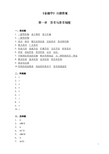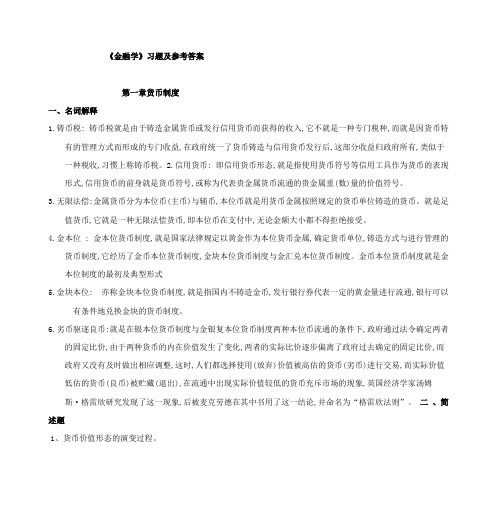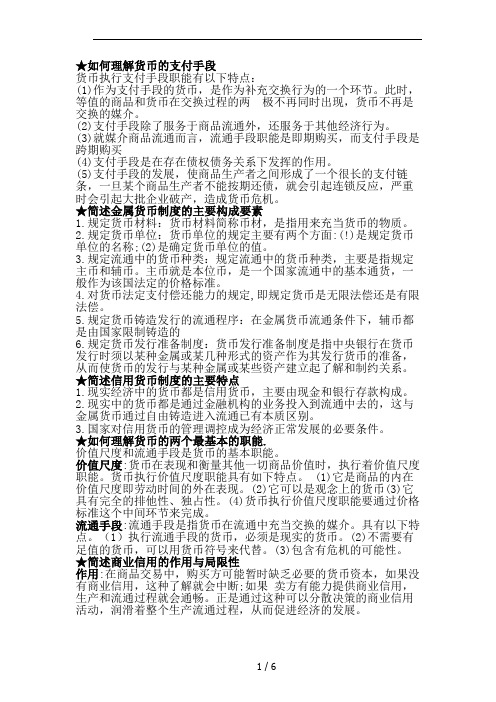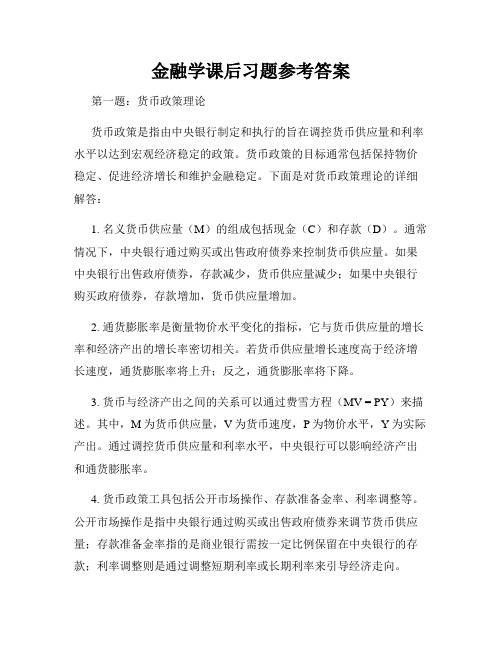《金融学》课后习题答案
《金融学》习题(答案)

《金融学》习题答案第一章货币与货币制度一、填空题1.一般等价物易于携带便于贮藏2.一般等价物3.纸币硬币银行活期存款近似货币货币替代物4.狭义货币广义货币5.价值尺度流通手段贮藏手段支付手段世界货币6.价值商品价值货币价值正比反比7.平衡国际贸易的差额购买外国商品从一国转移到另一国家8.银本位制复本位制金本位制纸币本位制9.格雷欣法则10.待售的商品数量商品的价格水平货币流通速度二、判断题1.×2.√3.×4.×5.×6.√7.√8.√9.×10.√三、选择题1.A2.ABCE3.A4.AC D5.ABCD6.A7.ACD8.ABC四、名词解释1.一般等价物——随着商品交换日益增多,交换地区扩大,充当商品交换媒介的物品就逐渐被固定在某种特殊的商品上,这种特殊的商品称为一般等价物。
而当一般等价物固定地由某种商品担当时,这种商品就成了货币。
2.信用货币——作为商品本身的价值与作为货币的价值不相等,并且不能用以兑现金银的货币,称为信用货币。
3.流通手段——货币在两种商品的交换关系中起着媒介的作用,即执行流通手段的职能。
4.货币制度——货币制度简称“币制”,是一个国家以法律形式规定的货币流通结构、体制与组织形式。
包括币材规定、货币单位、发行与流通程序、准备制度等。
5.格雷欣法则——是指定价过高(货币名义价值高于货币本身价值)的劣币把定价过低(货币名义价值低于货币本身价值)的良币驱逐出货币流通市场的趋势。
五、简答题:1.答:货币在商品经济中的职能是货币本质的具体表现,是商品交换所赋予的,也是人们运用货币的客观依据。
在商品经济中,货币执行着以下五种职能。
(1)在表现和衡量其他一切商品和劳务的价值时,执行价值尺度职能。
在执行这个职能时,可以用观念上的而不必是现实的货币,它把商品的价值表现为一定数量的货币。
商品价值的货币表现就是价格。
(2)在商品交换中充当交易的媒介,货币执行流通手段的职能。
2020年智慧树知道网课《金融学》课后习题章节测试满分答案

绪论单元测试1【判断题】(20分)间接融资是指资金供求双方通过商业银行等金融中介机构而间接融通资金。
在间接融资方式下,资金短缺单位与盈余单位并不发生直接的融资关系,而是通过银行等金融中介机构发生间接的融资关系。
A.对B.错2【多选题】(20分)金融体系的构成要素一般包括:A.金融制度B.金融工具C.金融市场D.金融机构3【多选题】(20分)金融资产具有的两个重要经济功能是:A.提供流动性功能B.资源配置功能C.风险转移功能D.提供信息功能4【判断题】(20分)从广义角度的金融创新来看,一部金融发展史就是一部金融创新的历史。
A.对B.错5【判断题】(20分)金融机构是金融交易活动的中介和金融体系的核心,是金融体系运行的组织者、推动者和管理者。
A.对B.错第一章测试1【单选题】(20分)从铸币时期开始,金属货币不再具有一般实物货币的基本属性,主要表现是因为()。
A.铸币的标准化B.名义价值和实际价值开始相分离C.国家信用成为载体D.运输成本下降2【单选题】(20分)综合物价指数上涨了25%,则货币购买力指数会()。
A.下降20%B.下降25%C.上涨25%D.上涨20%3【多选题】(20分)曾被人们誉为最理想的货币制度的金币本位制之所以崩溃的原因在于()。
A.金币不可以自由输出入国境B.黄金储量与产量难以维持经济发展对货币数量的要求C.金币失去自由铸造和自由熔化的前提D.黄金存量的分布不均4【判断题】(20分)银行券是银行发行的以其自身为债务人的债权债务凭证,早期作为最主要的一种代用货币可以随时兑现为金属货币,后来发展成为不可兑现的信用货币,但是其一直都是足值的货币。
A.错B.对5【单选题】(20分)在货币层次中M是指()。
A.回笼的现金B.流通中的现金C.贮藏的现金D.投放的现金第二章测试1【单选题】(20分)信用是:A.赠予行为B.买卖行为C.救济行为D.各种借货关系的总和2【单选题】(20分)利用信用卡透支属于:A.消费信用B.商业信用C.银行信用D.国家信用3【单选题】(20分)西方国家所说的基准利率,一般是指中央银行的:A.贷款利率B.存款利率C.市场利率D.再贴现利率4【单选题】(20分)名义利率与物价变动率的关系是:A.交叉相关关系B.负相关关系C.正相关关系D.无相关关系5【多选题】(20分)可贷资金利率决定理论认为,利率决定于:A.货币供给B.投资C.货币需求D.储蓄第三章测试1【单选题】(20分)下列不属于我国相关规定的外汇范畴的是()。
金融学(刘玉平)-课后部分简答题答案

第一章3.为什么说货币的出现降低了交易成本?物物交换:①搜寻成本②机会成本③直接成本一方面,简化交换方式,降低交易成本;另一方面,提高交换效率5.如何理解马克思对货币本质所做的表述?①一般等价物的商品②反映一定的社会关系6.不兑现的信用货币制度具有什么重要意义?货币供应量不受金银的控制,可以根据市场的需要做适当的调节纸币不与定量的金属相联系,其外汇汇率也不受国际市场价格的影响但是,通货膨胀问题第二章3.试述信用的主要形式。
商业信用和银行信用,最主要。
商业信用是现代信用制度的基础。
银行信用是在商业信用基础上发展起来的一种更高层次的信用,和商业信用一起构成社会信用体系的主体。
国家信用、消费信用、国际信用和民间信用。
4.试述商业信用的作用与局限性。
作用:①对经济的润滑和增长作用。
②调节企业之间的资金余额,提高资金使用效益,节约交易费用;是企业解决流通手段不足的首选方式。
③商业信用的合同化,有利于银行信用参与和支持商业信用,强化市场经济秩序。
局限性:①严格的方向性②产业规模的约束性③融资期限的短期性④信用链条的不稳定性⑤增加了政府宏观调控的难度5.银行信用为什么会取代商业信用,成为现代信用的主要形式?由于5点局限性,商业信用不可能从根本上改变社会资金和资源的配置与布局,也不可能广泛满足经济资源的市场配置和合理布局的需求。
因此,它虽然是商品经济社会的信用基础,但终究不能成为现代市场经济信用的中心和主导。
银行信用是在商业信用基础上发展起来的一种更高层次的信用,和商业信用一起构成社会信用体系的主体。
特点:①主体。
债务人是企业、政府、家庭和其他机构,债权人是银行及其他金融机构。
②客体是单一形态的货币资本。
③中介信用。
④与产业资本的动态不完全一致。
第三章2.什么是单利,什么是复利?利息的基本形式是单利还是复利?计算利息的两种方法。
将上期利息并入本金统算利息。
利息的基本形式是复利,考虑资金的时间价值3.影响利率的关键因素有哪些?1平均利润率(基本因素)2货币资金的供求状况3经济周期4物价水平5经济政策6其他影响因素4.关于利率的期限结构,有哪几种理论解释?1预期理论:长期债券的收益率应该等于现行短期利率和未来短期利率的几何平均值。
《金融学》习题及参考答案

《金融学》习题及参考答案第一章货币制度一、名词解释1.铸币税: 铸币税就是由于铸造金属货币或发行信用货币而获得的收入,它不就是一种专门税种,而就是因货币特有的管理方式而形成的专门收益,在政府统一了货币铸造与信用货币发行后,这部分收益归政府所有,类似于一种税收,习惯上称铸币税。
2.信用货币: 即信用货币形态,就是指使用货币符号等信用工具作为货币的表现形式,信用货币的前身就是货币符号,或称为代表贵金属货币流通的贵金属重(数)量的价值符号。
3.无限法偿:金属货币分为本位币(主币)与辅币,本位币就是用货币金属按照规定的货币单位铸造的货币。
就是足值货币,它就是一种无限法偿货币,即本位币在支付中,无论金额大小都不得拒绝接受。
4.金本位 : 金本位货币制度,就是国家法律规定以黄金作为本位货币金属,确定货币单位,铸造方式与进行管理的货币制度,它经历了金币本位货币制度,金块本位货币制度与金汇兑本位货币制度。
金币本位货币制度就是金本位制度的最初及典型形式5.金块本位: 亦称金块本位货币制度,就是指国内不铸造金币,发行银行券代表一定的黄金量进行流通,银行可以有条件地兑换金块的货币制度。
6.劣币驱逐良币:就是在银本位货币制度与金银复本位货币制度两种本位币流通的条件下,政府通过法令确定两者的固定比价,由于两种货币的内在价值发生了变化,两者的实际比价逐步偏离了政府过去确定的固定比价,而政府又没有及时做出相应调整,这时,人们都选择使用(放弃)价值被高估的货币(劣币)进行交易,而实际价值低估的货币(良币)被贮藏(退出),在流通中出现实际价值较低的货币充斥市场的现象,英国经济学家汤姆斯·格雷欣研究发现了这一现象,后被麦克劳德在其中书用了这一结论,并命名为“格雷欣法则”。
二、简述题1、货币价值形态的演变过程。
答:货币产生的社会背景就是人类的物品交换,货币诞生于商品交换,货币从萌芽到稳定于金属货币,就是生产力水平不断发展的体现。
金融学课后习题解答

★如何理解货币的支付手段货币执行支付手段职能有以下特点:(1)作为支付手段的货币,是作为补充交换行为的一个环节。
此时,等值的商品和货币在交换过程的两极不再同时出现,货币不再是交换的媒介。
(2)支付手段除了服务于商品流通外,还服务于其他经济行为。
(3)就媒介商品流通而言,流通手段职能是即期购买,而支付手段是跨期购买(4)支付手段是在存在债权债务关系下发挥的作用。
(5)支付手段的发展,使商品生产者之间形成了一个很长的支付链条,一旦某个商品生产者不能按期还债,就会引起连锁反应,严重时会引起大批企业破产,造成货币危机。
★简述金属货币制度的主要构成要素1.规定货币材料:货币材料简称币材,是指用来充当货币的物质。
2.规定货币单位:货币单位的规定主要有两个方面:(!)是规定货币单位的名称;(2)是确定货币单位的值。
3.规定流通中的货币种类:规定流通中的货币种类,主要是指规定主币和辅币。
主币就是本位币,是一个国家流通中的基本通货,一般作为该国法定的价格标准。
4.对货币法定支付偿还能力的规定,即规定货币是无限法偿还是有限法偿。
5.规定货币铸造发行的流通程序:在金属货币流通条件下,辅币都是由国家限制铸造的6.规定货币发行准备制度:货币发行准备制度是指中央银行在货币发行时须以某种金属或某几种形式的资产作为其发行货币的准备,从而使货币的发行与某种金属或某些资产建立起了解和制约关系。
★简述信用货币制度的主要特点1.现实经济中的货币都是信用货币,主要由现金和银行存款构成。
2.现实中的货币都是通过金融机构的业务投入到流通中去的,这与金属货币通过自由铸造进入流通已有本质区别。
3.国家对信用货币的管理调控成为经济正常发展的必要条件。
★如何理解货币的两个最基本的职能.价值尺度和流通手段是货币的基本职能。
价值尺度:货币在表现和衡量其他一切商品价值时,执行着价值尺度职能。
货币执行价值尺度职能具有如下特点。
(1)它是商品的内在价值尺度即劳动时间的外在表现。
《金融学》 教案大纲及习题解答(姜法芹 )

《金融学》教案大纲及习题解答第一章:金融学导论1.1 金融学的定义与意义金融学的概念金融学的研究对象与内容金融学的重要性1.2 金融市场与金融体系金融市场的概念与类型金融体系的组织结构金融市场与金融体系的关系1.3 金融学的应用领域企业金融个人金融宏观金融第二章:金融市场与金融工具2.1 金融市场的概念与类型金融市场的定义金融市场的类型与特点金融市场的作用与功能2.2 金融工具与金融产品金融工具的定义与分类金融产品的特点与功能金融工具与金融产品的选择与运用2.3 金融市场的参与者金融市场的主体与客体金融市场的投资者与融资者金融市场的服务机构第三章:金融市场的基本原理3.1 供求关系与价格机制金融市场的供求关系价格机制的作用与影响市场均衡与市场失灵3.2 金融市场的基本原理与应用金融市场的效率与有效性金融市场的风险与收益金融市场的信息与信号传递3.3 金融市场的微观结构金融市场的交易机制金融市场的信息不对称问题金融市场的交易成本与效率第四章:金融机构与金融体系4.1 金融机构的概念与类型金融机构的定义与特点商业银行与其他金融机构的比较金融机构的职能与作用4.2 金融体系的组织结构金融体系的构成要素金融体系的层次结构金融体系的监管与调控机制4.3 金融体系的功能与目标金融体系的基本功能金融体系的宏观调控目标金融体系的微观审慎监管目标第五章:金融市场与宏观经济5.1 金融市场与经济增长金融市场对经济增长的影响金融市场的规模与经济增长的关系金融市场的结构与经济增长的关系5.2 金融市场与货币政策货币政策的概念与目标金融市场在货币政策传导中的作用货币政策对金融市场的影响5.3 金融市场与金融稳定性金融稳定性的概念与意义金融市场在金融稳定性维护中的作用金融市场风险管理与监管的策略与措施《金融学》教案大纲及习题解答第六章:商业银行与存款货币银行6.1 商业银行的组织结构与运营模式商业银行的定义与特点商业银行的组织结构与管理体系商业银行的运营模式与业务流程6.2 存款货币银行的存款创造与信贷扩张存款创造的概念与机制信贷扩张的过程与影响存款货币银行的风险管理与信贷政策6.3 商业银行的金融服务与产品商业银行的存款与贷款产品商业银行的支付结算服务商业银行的金融服务创新第七章:资本市场与证券交易7.1 资本市场的概念与类型资本市场的定义与特点股票市场与债券市场的比较资本市场的功能与作用7.2 证券交易与投资分析证券交易的基本流程投资分析的方法与工具投资者偏好与投资组合的选择7.3 资本市场的效率与有效性资本市场效率的定义与衡量资本市场的有效性假说资本市场效率与有效性的实证研究第八章:金融衍生品市场8.1 金融衍生品的概念与类型金融衍生品的定义与特点期货、期权和掉期的比较金融衍生品市场的功能与作用8.2 金融衍生品的定价与风险管理金融衍生品的定价原理金融衍生品的风险类型与风险管理策略金融衍生品市场的风险监管与调控8.3 金融衍生品市场的应用与影响金融衍生品在企业金融中的应用金融衍生品在个人理财中的应用金融衍生品市场对金融体系的影响第九章:国际金融与外汇市场9.1 国际金融市场的概念与类型国际金融市场的定义与特点国际资本市场与国际外汇市场的比较国际金融市场的作用与影响9.2 外汇市场的运行机制与交易策略外汇市场的组织结构与交易机制外汇市场的汇率决定与变动外汇市场的交易策略与风险管理9.3 国际金融市场的关系与影响国际金融市场之间的联系与互动国际金融市场对国内经济的影响国际金融市场风险的识别与应对第十章:金融监管与金融政策10.1 金融监管的概念与目标金融监管的定义与意义金融监管的目标与原则金融监管的机构与体系10.2 金融政策的概念与工具金融政策的定义与类型货币政策与财政政策的比较金融政策的工具与传导机制10.3 金融政策的效应与评估金融政策的宏观经济效应金融政策的微观经济效应金融政策的评估方法与指标《金融学》教案大纲及习题解答第十一章:金融创新与金融科技11.1 金融创新的定义与类型金融创新的含义与动力金融创新的产品与服务金融创新的风险与监管11.2 金融科技的发展与应用金融科技的概念与特点数字货币与区块链技术金融科技在金融服务中的应用11.3 金融创新与金融监管的关系金融监管对金融创新的影响金融创新对金融监管的挑战金融监管与金融创新的平衡策略第十二章:金融风险与管理12.1 金融风险的定义与类型金融风险的概念与特征市场风险、信用风险和流动性风险的比较金融风险的管理与控制12.2 金融风险评估与度量金融风险评估的方法与模型金融风险度量的指标与工具金融风险评估的实践应用12.3 金融风险管理的策略与工具金融风险管理的框架与程序金融风险规避、分散与转移金融风险管理的创新与挑战第十三章:企业金融与公司财务13.1 企业金融的概念与功能企业金融的定义与目标企业金融的资本结构与投资决策企业金融的融资与理财策略13.2 公司财务的理论与实践公司财务的基本原则与目标公司财务的财务报表分析与估值公司财务的资本预算与资本结构13.3 企业金融与公司财务的挑战与趋势企业金融与公司财务的国际化企业金融与公司财务的可持续发展企业金融与公司财务的创新与发展第十四章:个人金融与理财规划14.1 个人金融的概念与内容个人金融的定义与意义个人资产与个人负债的管理个人金融产品的选择与运用14.2 理财规划的理论与方法理财规划的基本原则与步骤理财规划的工具与技术理财规划的实际操作与案例分析14.3 个人金融与理财规划的挑战与趋势个人金融市场的变化与趋势理财规划在个人金融中的应用个人金融与理财规划的创新与发展第十五章:金融伦理与职业道德15.1 金融伦理的概念与重要性金融伦理的定义与特点金融伦理在金融行业中的重要性金融伦理的挑战与问题15.2 职业道德的标准与原则职业道德的内涵与要求职业道德的实践与遵守职业道德的监督与教育15.3 金融伦理与职业道德的发展趋势金融伦理与职业道德的改进与完善金融行业职业道德建设的措施与方法金融伦理与职业道德的未来发展重点和难点解析本文档详细地编写了《金融学》教案大纲及习题解答,涵盖了金融学的基本概念、原理和应用。
《金融学》课后答案

第一章货币与货币制度1.钱、货币、通货、现金是一回事吗?银行卡是货币吗?答:(1)钱、货币、通货、现金不是一回事,虽然其内容有所重叠,但这几个概念之间是有区别的。
钱是人们对货币的俗称。
经济学中被称为货币的东西,就是在日常人们生活中被称为钱的东西。
货币是由国家法律规定的,在商品劳务交易中或债务清偿中被社会普遍接受的东西。
通货即流通中的货币,指流通于银行体系外的货币。
现金就是指家庭个人、工商企业、政府部门所拥有的现钞,包括纸币现钞、硬币现钞。
现金是货币的一部分,这部分货币的流动性强,使用频率高,对人们日常消费影响大。
(2)银行卡亦称“塑料货币”,是由银行发行,供客户办理存取款等业务的新型服务工具的总称,包括信用卡、支票卡、记账卡、自动出纳机卡、灵光卡等。
各种银行卡是用塑料制作的,可用于存取款和转账支付。
现在,特别在西方发达国家,各种银行卡正逐步取代现钞和支票,成为经济生活中广泛运用的支付工具。
因此,在现代社会银行卡也属于货币。
2.社会经济生活中为什么离不开货币?为什么自古至今,人们又往往把金钱看作是万恶之源?答:(1)社会经济生活离不开货币,货币的产生和发展都有其客观必然性。
物物交换的局限性要求有某种商品充当共同的、一般的等价物,而金银的特性决定其成为货币的天然材料。
作为货币的金银等贵金属,便于携带、铸造和分割,大大推动了商品经济的发展。
随着经济的发展,货币形态不断发生变化。
经历了实物货币阶段、贵金属货币阶段、代用货币阶段和信用货币阶段。
当今货币正朝着专门化、无体化、扩张化、电子化的趋势发展。
但不管货币的具体形态如何,都是媒介商品经济所必需的。
对货币的使用是实现市场对资源合理配置的必要条件,也是市场经济正常运行的必要条件。
从这个意义上说,市场经济实际上是一种货币经济:货币方便了市场交换,提高了市场效率;货币保证了社会需求的实现,促进了市场对资源的有效配置。
从交易成本上看,节约是经济生活中最基本的规律。
金融学课后习题参考答案

金融学课后习题参考答案第一题:货币政策理论货币政策是指由中央银行制定和执行的旨在调控货币供应量和利率水平以达到宏观经济稳定的政策。
货币政策的目标通常包括保持物价稳定、促进经济增长和维护金融稳定。
下面是对货币政策理论的详细解答:1. 名义货币供应量(M)的组成包括现金(C)和存款(D)。
通常情况下,中央银行通过购买或出售政府债券来控制货币供应量。
如果中央银行出售政府债券,存款减少,货币供应量减少;如果中央银行购买政府债券,存款增加,货币供应量增加。
2. 通货膨胀率是衡量物价水平变化的指标,它与货币供应量的增长率和经济产出的增长率密切相关。
若货币供应量增长速度高于经济增长速度,通货膨胀率将上升;反之,通货膨胀率将下降。
3. 货币与经济产出之间的关系可以通过费雪方程(MV = PY)来描述。
其中,M为货币供应量,V为货币速度,P为物价水平,Y为实际产出。
通过调控货币供应量和利率水平,中央银行可以影响经济产出和通货膨胀率。
4. 货币政策工具包括公开市场操作、存款准备金率、利率调整等。
公开市场操作是指中央银行通过购买或出售政府债券来调节货币供应量;存款准备金率指的是商业银行需按一定比例保留在中央银行的存款;利率调整则是通过调整短期利率或长期利率来引导经济走向。
第二题:投资组合理论投资组合理论是指通过合理配置不同资产的比例和权重,以降低风险并提高收益的投资策略。
下面是对投资组合理论的详细解答:1. 投资组合的关键是在不同的资产之间寻求相关性较小或负相关的资产以降低系统风险。
相关性较小的资产可以互相抵消风险,从而提高组合的整体表现。
2. 投资者可以通过构建有效前沿曲线来选择最优投资组合。
有效前沿曲线代表了在给定风险水平下,可以获得的最大收益。
投资者可以在有效前沿曲线上选择适合自己风险偏好的投资组合。
3. 马科维茨提出了资本资产定价模型(CAPM),该模型可以帮助投资者确定资产的预期收益率。
CAPM模型认为,资产的预期收益率与市场风险有关,市场风险可以通过贝塔系数来度量。
- 1、下载文档前请自行甄别文档内容的完整性,平台不提供额外的编辑、内容补充、找答案等附加服务。
- 2、"仅部分预览"的文档,不可在线预览部分如存在完整性等问题,可反馈申请退款(可完整预览的文档不适用该条件!)。
- 3、如文档侵犯您的权益,请联系客服反馈,我们会尽快为您处理(人工客服工作时间:9:00-18:30)。
CHAPTER 1WHAT IS FINANCE?Objectives∙Define finance.∙Explain why finance is worth studying.∙Introduce the main players in the world of finance—households and firms—and the kinds of financial decisions they make.Outline1.1 Defining Finance1.2 Why Study Finance?1.3 Financial Decisions of Households1.4 Financial Decisions of Firms1.5 Forms of Business Organization1.6 Separation of Ownership and Management1.7 The Goal of Management1.8 Market Discipline: Takeovers1.9 The Role of the Finance Specialist in a CorporationSummaryFinance is the study of how to allocate scarce resources over time. The two features that distinguish finance are that the costs and benefits of financial decisions are spread out over time and are usually not known with certainty in advance by either the decision-maker or anybody else.A basic tenet of finance is that the ultimate function of the system is to satisfy people’s consumption preferences. Economic organizations such as firms and governments exist in order to facilitate the achievement of that ultimate function. Many financial decisions can be made strictly on the basis of improving the tradeoffs available to people without knowledge of their consumption preferences.There are at least five good reasons to study finance:∙To manage your personal resources.∙To deal with the world of business.∙To pursue interesting and rewarding career opportunities.∙To make informed public choices as a citizen.∙To expand your mind.The players in finance theory are households and business firms. Households occupy a special place in the theory because the ultimate function of the system is to satisfy the preferences of people, and the theory treats those preferences as given. Finance theory explains household behavior as an attempt to satisfy those preferences. The behavior of firms is viewed from the perspective of how it affects the welfare of households.Households face four basic types of financial decisions:∙Saving decisions: How much of their current income should they save for the future?∙Investment decisions: How should they invest the money they have saved? ∙Financing decisions: When and how should they use other people’s money to satisfy their wants and needs?∙Risk management decisions: How and on what terms should they seek to reduce the economic uncertainties they face or to take calculated risks?There are three main areas of financial decision-making in a business: capital budgeting, capital structure, and working capital management.There are five reasons for separating the management from the ownership of a business enterprise:∙Professional managers may be found who have a superior ability to run the business.∙To achieve the efficient scale of a business the resources of many households may have to be pooled.∙In an uncertain economic environment, owners will want to diversify their risks across many firms. Such efficient diversification is difficult to achieve without separation of ownership and management.∙Savings in the costs of gathering information.∙The “learning curve” or “going concern” effect. When the owner is also the manager, the new owner has to learn the business from the old owner in order to manage it efficiently. If the owner is not the manager, then when the business is sold, the manager continues in place and works for the new owner.The corporate form is especially well suited to the separation of ownership and management of firms because it allows relatively frequent changes in owners by share transfer without affecting the operations of the firm.The primary goal of corporate management is to maximize shareholder wealth. It leads managers to make the same investment decisions that each of the individual owners would have made had they made the decisions themselves.A competitive stock market imposes a strong discipline on managers to take actions to maximize the market value of the firm’s shares.Solutions to Problems at End of Chapter1. What are your main goals in life? How does finance play a part in achieving those goals? What are the major trade-offs you face? SAMPLE ANSWER:∙Finish school∙Get good paying job which I like∙Get married and have children∙Own my own home∙Provide for family∙Pay for children’s education∙RetireHow Finance Plays a Role:SAMPLE ANSWER:∙Finance helps me pay for undergraduate and graduate education and helps me decide whether spending the money on graduate education will be a good investment decision or not.∙Higher education should enhance my earning power and ability to obtain a job I like.∙Once I am married and have children I will have additional financial responsibilities (dependents) and I will have to learn how to allocate resources among individuals in the household and learn how to set aside enough money to pay for emergencies, education, vacations etc. Finance also helps me understand how to manage risks such as for disability, life and health.∙Finance helps me determine whether the home I want to buy is a good value or not. The study of finance also helps me determine the cheapest source of financing for the purchase of that home.∙Finance helps me determine how much money I will have to save in order to pay for my children’s education as well as my own retirement.Major Trade-Offs:SAMPLE ANSWER∙Spend money now by going to college (and possibly graduate school) but presumably make more money once I graduate due to my higher education.∙Consume now and have less money saved for future expenditures such as for a house or car OR save more money now but consume less than some of my friends.2. What is your net worth? What have you included among your assets and your liabilities? What have you excluded that you might have included?SAMPLE ANSWER:$ ____________ (very possibly negative at this point)Assets:∙Checking account balance∙Savings account balance∙Furniture/Jewelry (watch)∙Car (possibly)Liabilities:∙Student loans∙Credit card balance∙If renting, remainder of rental agreement (unless subletting is a possibility) ∙Car payments (possibly)Students typically exclude the high value of their potential lifetime earning power when calculating their net worth.3. How are the financial decisions faced by a single person living alone different from those faced by the head of a household with responsibility for several children of school age? Are the tradeoffs they have to make different, or will they evaluate the tradeoffs differently?A single person needs only to support himself and therefore can make every financial decision on his own. If he does not want health insurance (and is willing to bear the financial risks associated with that decision) then no one will be affected by that decision other than that single person. In addition, this person needs to make no decisions about allocating income among dependents. A single person is very mobile and can choose to live almost anywhere. The tradeoffs this individual makes generally concern issues of consuming (or spending) today versus saving for consumption tomorrow. Since this person is supporting only himself, the need to save now is less important than for the head of household discussed next.The head of household with several children must share resources (income) among dependents. This individual must be prepared to deal with risk management issues such as how to be prepared for potential financial emergencies (such as a serious health problem experienced by a member of the family or home owners insurance in case of a fire or other mishap). Because there are more people in this household than with a single person, there are greater risks that someone will get sick or injured. And because there are dependents, the wage earner(s) should think carefully about life and disability insurance. In addition, the family is not as mobile as the single individual. Because of the school age children, the family might want to live near “good schools” thinking that a stronger education will eventually help those children’s future well being and financial situation. Thus, the tradeoffs for the head of household are more complex: more money is needed to consume today (he or she needs to support more dependents), but a lot more money is also needed to save for future expenses such as education and housing and more money is needed for risk management such as life and disability insurance.4. Family A and family B both consist of a father, mother and two children of school age. In family A both spouses have jobs outside the home and earn a combined income of $100,000 per year. In family B, only one spouse works outside the home and earns $100,000 per year.How do the financial circumstances and decisions faced by the two families differ?With two wage earners, there is less risk of a total loss of family income due to unemployment or disability than there is in a single wage earning household. The single wage earning family will probably want more disability and life insurance than the two wage earning family. On the flip side, however, the two wage earning family may need to spend extra money on child care expenses if they need to pay someone to watch the children after school.5. At what age should children be expected to become financially independent?Students will have differing responses to this question depending upon their specific experiences and opinions. Most will probably say independence should come after finishing their education, and they have a decent paying job.6. You are thinking of buying a car. Analyze the decision by addressing the following issues:a.Are there other ways to satisfy your transportation requirementsbesides buying a car? Make a list of all the alternatives and write down the pros and cons.b.What are the different ways you can finance the purchase of a car? Finance through a bank loan or lease, finance through a car dealer with a loan or a lease or finance the car out of your own savings.c.Obtain information from at least three different providers ofautomobile financing on the terms they offer.d.What criteria should you use in making your decision?Your decision will be to select the financing alternative that has the lowest cost to you.When analyzing the information, you should consider the following:∙Do you have the cash saved to make an outright purchase? What interest rate would you be giving up to make that purchase? Do you pay a different price for the car if you pay cash rather than finance?∙For differing loan plans, what is the down payment today? What are the monthly payments? For how long? What is the relevant interest rate you will be paying? Does the whole loan get paid through monthly payments or is there a balloon payment at the end? Are taxes and/or insurance payments included in the monthly payments?∙For differing lease plans, what is the down payment today? What are the monthly payments? For how long? Do you own the car at the end of the lease? If not, what does it cost to buy the car? Do you have to buy the car at the end of the lease or is it an option? Is there a charge if you decide not to buy the car? What relevant interest rate will you be paying? Are taxes and/or insurance payments included in the monthly payments? Are there mileage restrictions?7. You are thinking of starting your own business, but have no money.a.Think of a business that you could start without having to borrow anymoney.Any business which involves a student’s own personal service would be cheap to start up. For instance he or she could start a business running errands for others, walking their dogs, shopping etc. Along those same lines they could start some kind of consulting business. Both of these businesses could be run out of their dorm room or their own home and could be started with very little capital. If they wanted to hire additional workers, they would have to be paid on a commission basis to limit upfront expenses.b.Now think of a business that you would want to start if you couldborrow any amount of money at the going market interest rate. Certainly there are many interesting businesses which could be started if one could finance 100% of the business with borrowed capital and no equity. Since you will be able to borrow 100% of the financing, you will be willing to take a lot greater risk than if you were investing your own money.c.What are the risks you would face in this business?[Answer is, of course, dependent on answer to question “b.”]d.Where can you get financing for your new business?Depending upon the size of the financing needed, students should be looking for both debt and equity financing. The sources of this financing ranges from individuals and credit cards (for very small sums) to banks, venture capitalists, public debt and equity markets, insurance companies and pension funds8. Choose an organization that is not a firm, such as a club or church group and list the most important financial decisions it has to make. What are the key tradeoffs the organization faces? What role do preferences play in choosing among alternatives? Interview the financial manager of the organization and check to see if he or she agrees with you. SAMPLE ANSWER:Local Church group. Most important financial decisions:∙Whether or not to repair damage done to church and grounds during last big hurricane (specifically repairing the leaking roof)∙What project to put off in order to pay for repair damage∙How to pay for renovations to downstairs Sunday school rooms∙How to increase member attendance and contributions∙How to organize and solicit volunteers for the annual Church Sale (largest fund raiser of the year)Key Tradeoffs and Preferences:Church group funds are severely limited, so the organization needs to prioritize expenses based upon cost and need. Not all projects that are needed will be undertaken due to the expense involved. An equally large amount of time will be spent trying to raise financing since funds inflow is variable. Since not all projects can be financed, preferences of differentFinance Instructor’s Manual Chapter 1Page 27 important individuals (such as the pastor) take on great significance in the decision-making process.。
